If You’re Gonna Show Up, Make It Count. Let’s Go.
Full disclosure: I’m not American. Not even close. But after years of working with U.S.-based clients, I’ve learned this: if you’re targeting American consumers, the 4th of July is more than a holiday. It’s also a prime opportunity to drive sales.
This holiday moves fast. One minute you're planning summer content, and the next — your competitors are already launching Independence Day promotions and pushing flash deals like it's the Super Bowl of ecommerce.
So if you’re searching for 4th of July marketing ideas that actually lead to clicks, signups, and purchases — not just confetti and crickets — you’re in the right place.
Here’s why this moment matters:
87% of U.S. consumers celebrated the 4th of July last year — more than Valentine’s, Mother’s, or Father’s Day
32% plan to buy patriotic products this year (source: NRF)
Your audience is already in a buying mindset. You just need to meet them with something worth acting on.
So no, this isn’t another list of tired July 4th sales strategies like “10% off everything” and a stock photo of sparklers.
These are smart, engaging, conversion-first holiday marketing tips designed for small businesses and scrappy creators who want real results — not just clicks and confetti.
Let’s make this the seasonal marketing campaign that actually hits. Ready? Let’s go.
Before You Dive In… Let’s Be Honest About What Doesn’t Work
You know those 4th of July campaigns that feel like an afterthought?
A half-hearted 10% off code. Some red and blue confetti slapped on a graphic. A subject line that basically says, “We did something, right?”
That’s not strategy — that’s scrambling. And your audience can tell.
If your goal is to get clicks, build trust, or actually make sales, you need more than a discount and a themed font. Especially when everyone else is shouting over the same holiday weekend.
You don’t have to be flashy. But you do have to be intentional.
This is what actually works: a message that feels like it was meant for the person reading it.
And no, you don’t need weeks of prep or a massive team to pull that off. Just a little intention goes a long way — especially during holidays, when people are already primed to shop.
I did a bit of research and according to Epsilon, 80% of consumers are more likely to purchase from brands that offer personalized experiences.
McKinsey backs it up, too: smart personalization can increase sales conversions by up to 15%.
That applies to your seasonal marketing just as much as it does to your evergreen stuff.
So instead of reaching for a last-minute sale, ask:
What’s actually happening in my customer’s world right now?
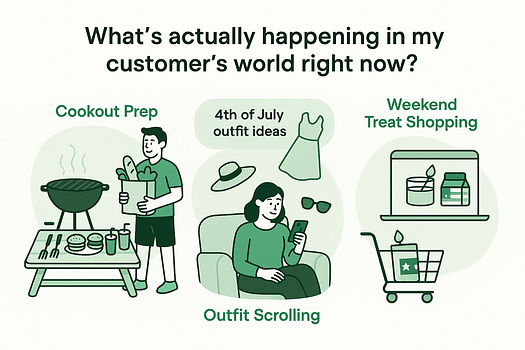
Are they prepping for a cookout? Scrolling for outfit inspo? Looking for something fun to splurge on for the weekend?
Meet them there.
The ideas I’m about to share aren’t gimmicks or random generic stuff you’ll find anywhere (otherwise you wouldn’t be here).
They’re built to grab attention, guide behavior, and drive real results. And this applies to anyone, whether you’re promoting a product, a download, or a local service. I’ve also made sure that they’re fast to launch, even if you’re a little late to the party.
Let’s get into it.
A Conversion-Focused Strategy for 4th of July Campaigns
If you want your 4th of July campaign to actually work, you need more than a cute color palette and a “limited-time” sticker slapped on your hero section. The secret? Keep it focused.
Every element should have a job:
Pull someone in.
Get them to stay.
Move them one step closer to a sale.
Here’s how to pull that off, even if you’re starting now.
1. Build a Dedicated Landing Page
If you’re running a 4th of July promotion and sending people to your homepage… I’m saying this kindly: please stop.
Your homepage is multitasking its heart out — product categories, about pages, blog links from 2021. It’s doing too much. And during a seasonal promotion, you want fewer distractions, not more.
This is where a dedicated landing page shines. It gives you space to run a focused, high-impact patriotic marketing campaign that guides people straight to action.
Here’s what your holiday landing page should include:
One clear offer. Not two. Not “browse our store.” Just one.
A July 4th vibe that still feels on-brand. Use red, white, and blue if you like — just skip the stock photo of fireworks behind your CTA button.
A conversion-focused layout. Headline → benefit → product image → call to action → social proof. Maybe a countdown timer, if it fits.
Mobile-first design. Because most people are shopping poolside or in line at the grocery store.
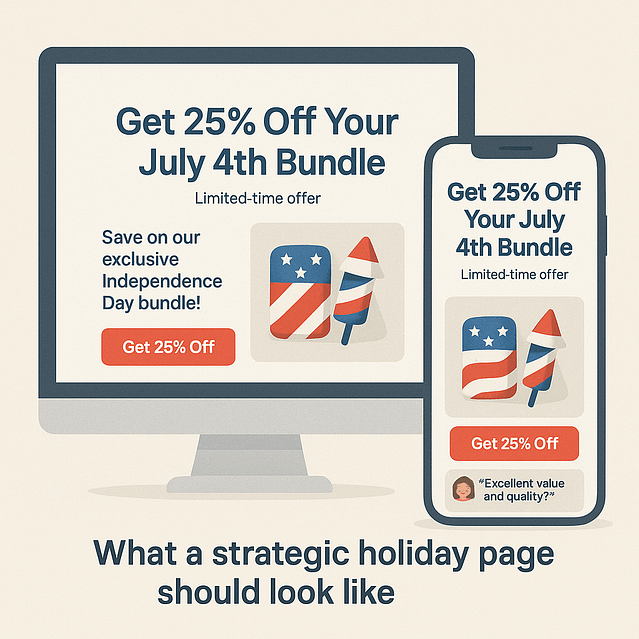
Need more tips on how to build a landing page correctly? Our step-by-step tutorial can help you achieve just that.
You’re building more than a page here. The goal is to create a moment that leads to someone saying, “heck yeah, I want that.”
And you don’t need to overthink it — this kind of page is one of the easiest holiday marketing tips to pull off quickly. You can use it to feature a limited-time offer, promote a patriotic bundle, or even run a July 4th sales strategy like “Buy 3, Get 1 Free (Freedom Edition).”
Because when your page is focused and festive, your audience doesn’t have to think twice. They know exactly where they are, what the offer is, and how to grab it.
That’s how seasonal marketing turns into real revenue.
🧰 Try This (Without Fighting Your Theme)
💡 Need a quick way to build your 4th of July landing page without breaking your site layout? I use Thrive Architect for this kind of thing — it’s a drag-and-drop builder made for people who want to get in, create something that looks good and converts, and get out.
✔️ Mobile-ready right out the gate ✔️ Built-in countdowns, testimonials, CTA blocks — just drop them in ✔️ You don’t have to wrestle with shortcodes or your theme settings for 45 minutes
It’s everything your holiday page needs, minus the headache.
2. Launch a Popup That Doesn’t Annoy People
Let me tell you, I’m a patient person.
I’m the “I’ll watch the whole 2 minute ad just to get more lives on my mobile game” kind of patient.
But what will send me off a website faster than you can say unsubscribe?A popup that interrupts me before I’ve even read the site title, yelling “WAIT! DON’T LEAVE!” like we’re in a breakup scene from Beverly Hills: 90210.
Popups get a bad rep because most of them are loud, desperate, and completely disconnected from what the visitor is doing. But here’s what most people miss:
When they’re timed right and offer something people actually want, popups are one of the most effective tools in your 4th of July marketing strategy.
We’re talking 11.09% average conversion rates, with top performers reaching up to 42.35%.
Here’s how to make yours helpful instead of horrifying:
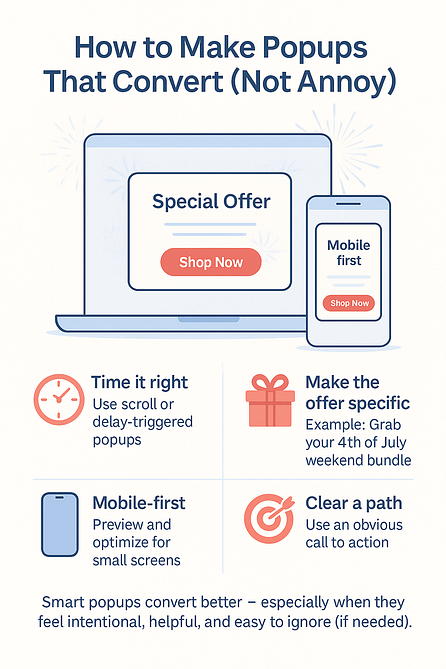
✳️ Be a good guest — time it right
Let people breathe before throwing a box in their face
Use scroll-based or time-delay triggers (10–15 seconds is a sweet spot)
Exit-intent popups still work, but only if they’re not emotionally manipulative
✳️ Make the offer worth their attention
Try:
“Grab your 4th of July weekend bundle”
“Unlock your summer freebie before the fireworks start”
“Here’s your red, white & blue bonus — claim it before it’s gone”
The more specific and seasonal the offer, the more likely it is to convert. Think beyond the discount — and tie it into the rest of your holiday campaign so it feels intentional, not random.
✳️ Match the vibe, not the noise level
Keep the design clean and on-brand
Use light backgrounds, festive (but not cheesy) visuals
And for the love of all things summer, make sure it looks good on mobile
Want to see what a smart popup actually looks like?
Check out our step-by-step guide to creating popups that convert — with tips on timing, targeting, and offers that don’t feel like an ambush.
🧰 How I Set This Up Without Losing My Mind
💡 Popups work — when you’re not wrestling your tools just to get one live. I use [Thrive Leads] because it makes building and testing popups ridiculously easy.
✔️ Scroll, timer, exit-intent — all covered
✔️ A/B testing that actually makes sense
✔️ Mobile-ready designs with just enough personality
Honestly, it’s one of the fastest ways to make a holiday campaign feel intentional (and to stop leaving conversions on the table).
3. Let Customers Choose Their Deal
Here’s a little psychology secret: people are more likely to follow through when they feel like they made the decision themselves.
It’s backed by Self-Determination Theory — a core idea in behavioral science that says autonomy (aka feeling in control) boosts motivation. And it absolutely applies to your 4th of July marketing strategy.
The typical July 4th sales strategy? One-size-fits-all: “Here’s 15% off — take it or leave it.”
But when you give your audience even a little control over how they engage with your offer, conversions go up. They’re choosing their path, not being pushed.
👉 How to Give People a Choice (Without Overcomplicating It)
Let’s say you're running a seasonal promotion for Independence Day. Instead of offering just one default deal, try a segmented approach right on your landing page or popup:
“Want to save now?” → Links to a discount bundle with your top products
“Want something extra?” → Unlocks a free gift with purchase (think bonus product, upgrade, or digital extra)
“Just browsing?” → Offers early access to your next promo in exchange for an email
Why it works: Each option aligns with a different type of shopper — the deal hunter, the value-seeker, and the long-game browser. It’s subtle personalization without heavy lifting.
👉 Want to Level Up? Turn It Into a Quiz
This is where quiz-based lead generation shines — especially if you want to collect emails, segment your audience, and make the whole experience feel a little more fun.
Example quiz: What’s Your 4th of July Vibe?
Ask a few quick questions like:
How are you spending the weekend?
What’s your go-to 4th of July food?
Pick your ideal vibe: BBQ, fireworks, chill
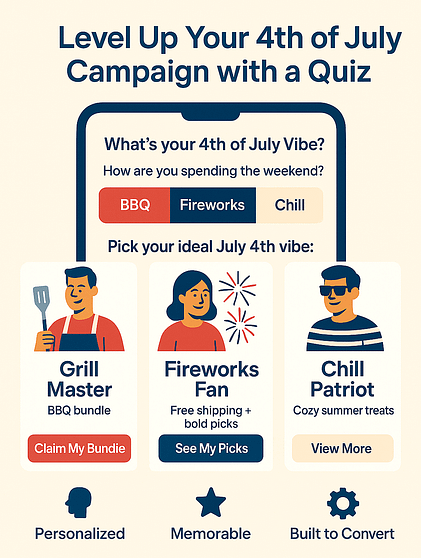
Then match their result to a themed offer:
Grill Master → BBQ bundle with a spicy little discount
Fireworks Fan → Free shipping and bold product picks
Chill Patriot → Cozy summer goodies with a low-key CTA
Now your patriotic campaign is doing triple duty: ✅ Personalized ✅ Memorable ✅ Built to convert
And your follow-up emails? Instantly smarter.
📊 Why This Works
Quizzes convert up to 50% of participants into leads
Interactive content generates 2x more engagement than static content
Personalized marketing increases revenue by 10–15%
Choice = commitment. And commitment = conversions.
🧰 Want Leads You Can Actually Do Something With?
💡 Running a quiz isn’t just about lead gen — it’s about getting the right offer in front of the right person. With Thrive Quiz Builder, you’re not just collecting emails — you’re segmenting based on what people actually care about.
✔️ Create quiz flows that feel personal
✔️ Send targeted offers based on quiz results
✔️ Turn browsers into buyers with data you can use right away
Perfect for holiday promos, evergreen funnels, or any campaign where “blast everyone” isn’t cutting it anymore.
4. Don’t Just Send One Email — Use a Micro Sequence
Let me guess. You've got the perfect offer, wrote a killer subject line, hit send… and then nothing.
It’s not you. It’s the week. People are packing coolers, chasing toddlers, panic-buying fireworks, and getting email after email from brands shouting SALE! in all caps.
If you only send one message, you’re gambling on perfect timing. And unless you’re psychic (and if you are, I have questions), that’s risky business.
The fix? A short, well-timed sequence that keeps you top of mind without being overbearing. Just 2–3 emails. That’s it. It’s one of the easiest holiday marketing tips to pull off — and it makes your seasonal campaign feel like a real experience, not a one-off.
✅ Here’s the 3-email flow I swear by:
Email 1: The Tease
📅 Send 2–3 days before your offer goes live Think: “Something festive’s coming… and you’re gonna want to be ready.” Just enough to spark curiosity. Maybe hint at a bonus, early access, or limited availability.
Email 2: The Main Event
📅 Send July 3rd or morning of the 4th This is the full reveal. Be clear, bold, and benefit-driven. Think: “Here’s the deal, here’s why it’s great, and here’s what to do now.”
Email 3: The Last Call
📅 Send evening of the 4th Remind them this is wrapping up soon. Think: “Last chance to grab your bonus before the sparklers go out.” Resend to people who didn’t open the first time, and don’t overthink it — this one’s about urgency.
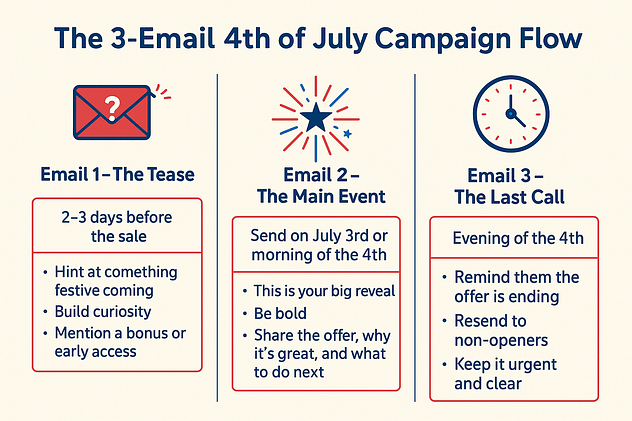
💡 Why This Works
- Most people need a few nudges before they act — especially during busy weeks
- You’re staying visible without being spammy
- And you’re making space for the “I meant to come back to this” crowd (they’re real, and they convert)
Plus, once this sequence is set up? You can reuse it. Swap the theme, update the dates, and suddenly your next campaign or flash sale is 70% done.
5. Use Scarcity + Social Proof (But Keep It Real)
I love a little urgency — I really do.
But if I land on your 4th of July page and see a countdown screaming “Only 3 minutes left!”… and then it magically resets every time I come back? Yeah, no. That's not urgency. That’s ✨digital gaslighting✨.
Scarcity and social proof absolutely work, but they need to feel genuine.
During a seasonal promotion, the holiday already gives you a built-in reason to act fast — so don’t overcook it. Just highlight what’s real, what’s limited, and what’s working… and let your audience decide.
✅ Scarcity: The “Oh No, I Might Miss It” Effect
Scarcity isn’t about pressure — it’s about clarity.
Here are three ways to do it well:
Time-based scarcity: “Ends at midnight on July 4th — no extensions.”
Quantity-based scarcity: “Only 50 bonus bundles available.”
Milestone scarcity: “Free gift unlocks for the first 100 orders.”
The key? Stick to what you say. Scarcity only builds urgency when your audience knows you mean it.
📊 Time-based scarcity can boost conversion rates by up to 30%. When shoppers know the clock’s ticking — and you’re not bluffing — they’re more likely to act.
✅ Social Proof: Show, Don’t Shout
You don’t need a wall of reviews and five trust badges to prove your offer is good. You just need to show people are into it — and that you’re not the only one saying it’s worth it.
Try these:
A simple customer quote: “This bundle made our backyard BBQ”
A UGC repost: someone showing off their purchase on Instagram
A quick stat: “Over 900 people grabbed this deal last 4th of July weekend”
It’s low-key, real, and way more believable than the mystery “4.8-star average” from 38,942 anonymous names.
📊 Adding testimonials can increase conversions by up to 34%. Not bad for something you already have in your inbox.
💡 Why This Works
Scarcity gives people a reason to buy now. Social proof reassures them they’re not the only one. Together? You get the golden combo: urgency without anxiety — and a patriotic campaign that feels both exciting and trustworthy.
Quick Tip: Want to Add Real Scarcity Without Faking It?
💡 Use [Thrive Ultimatum] to add real countdowns that end when they say they will — no shady refresh hacks. Pair it with [Thrive Architect] to drop in testimonials, product counters, and seasonal urgency banners — all in minutes, not hours.
Your offer stays honest. Your campaign looks sharp. And your conversions? Way happier.
And if you need to automate testimonials to show up on your pages, Thrive Ovation is your answer. Need help setting this up? This tutorial will help.
6. Actually Celebrate With Your Audience
It’s a holiday. You don’t have to act like you’re running a year-end clearance at a tire shop.
So many 4th of July marketing campaigns feel weirdly... corporate. But what if you leaned into the vibe a little? Not everything has to be a sales pitch. Sometimes, the best conversion play is making your audience feel like they’re part of something.
Here’s how to bring the energy without burning yourself out:
✅ Get a Little Festive in Public
You don’t have to throw a parade (unless you want to), but a few light-touch ideas go a long way:
- Post behind-the-scenes: your workspace, your team, your messy-but-cute DIY decor
- Share a reel or story showing how you’re spending the 4th — product in hand, optional
- Invite engagement: “What’s your ultimate BBQ side dish? Go.”
No big promo. Just presence. It builds trust, shows there’s a human behind the brand, and sets you apart from all the templated promo graphics flying around.
It’s a low-effort way to deepen relationships and gently nudge conversion without being pushy
✅ Run a Mini Giveaway or Poll
People love participating — especially when there’s something fun or useful involved.
Try this:
- A quick poll: “Fireworks or sparklers?” “Backyard BBQ or beach day?” → Use the responses as a conversation starter in your next email
- A mini-giveaway: “Comment to win a patriotic freebie pack” — even a $10 bonus product can feel exciting when it’s framed well (set it up with RafflePress)
Bonus: this kind of holiday marketing content is super shareable — and you get organic reach without begging for it.
✅ Highlight Your Community
This one’s so underused: Celebrate your customers.
- Share a few of their photos using your product
- Create a “customer favorites” roundup for the holiday
- Add a story slide that’s just “We’re grateful for you” — that’s it, no CTA
Why? Because connection builds loyalty — and loyal customers don’t wait for a discount to buy again.
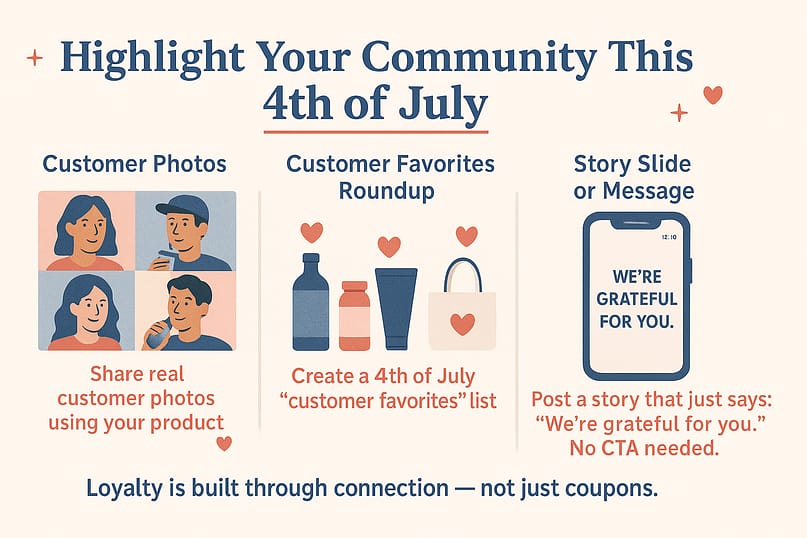
💡 Why This Works
- People buy from people — and holidays are a great time to remind them there’s a real one behind your brand
- Celebratory content stands out in a sea of “buy now” emails
7. Don’t Let the Momentum Die on July 5
The promo’s done, but your opportunity isn’t. The days after your 4th of July campaign are when warm leads either convert — or cool off for good.
Keep the energy going with a few quick moves:
Send a quick thank-you email → Include a fun stat or moment (“We sold out of grill kits in 12 hours!”) → Add a soft CTA: follow, tag, or stay tuned for what’s next
Offer a light encore to almost-buyers → One follow-up with a second-chance vibe: “We saved a few extra gift bundles — want one?”
Put your new data to work → Segment quiz takers → Reuse UGC in your next promo → Start a simple 3–email nurture series (value → story → soft offer)
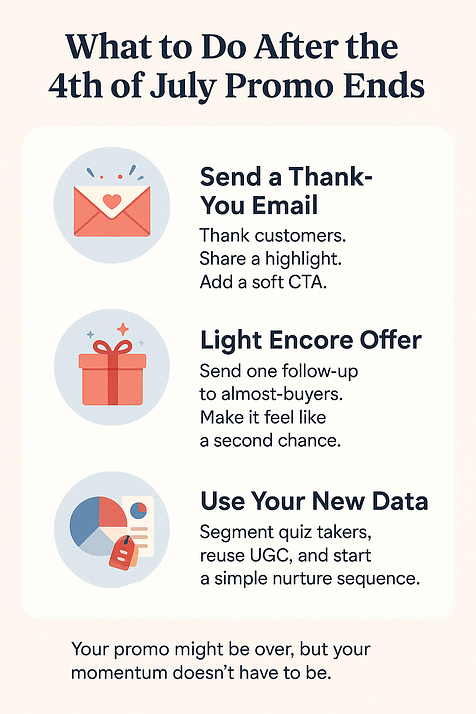
💡 Why This Works
You’re not starting from scratch — you’re building on the momentum you’ve already earned. And that’s where the real magic (and long-term ROI) kicks in.
8. Create a “Red, White, and YOU” Loyalty Builder
I’ve seen firsthand how a simple loyalty challenge can turn a seasonal promo into something people actually want to come back for.
And I’m not the only one — 74% of consumers say they’d engage more with brands offering tiered rewards based on spend.
So if you want to celebrate your repeat buyers (and give them a reason to shop again before July 5), try this:
🔁 The Tiered Setup
Spend $40 → Free digital bonus (guide, checklist, recipe pack)
Spend $70 → Unlock a limited-time bundle
Spend $100 → Entry into a VIP prize draw
It feels like a challenge — not just a sale — and gives your biggest fans something fun (and conversion-friendly) to aim for.
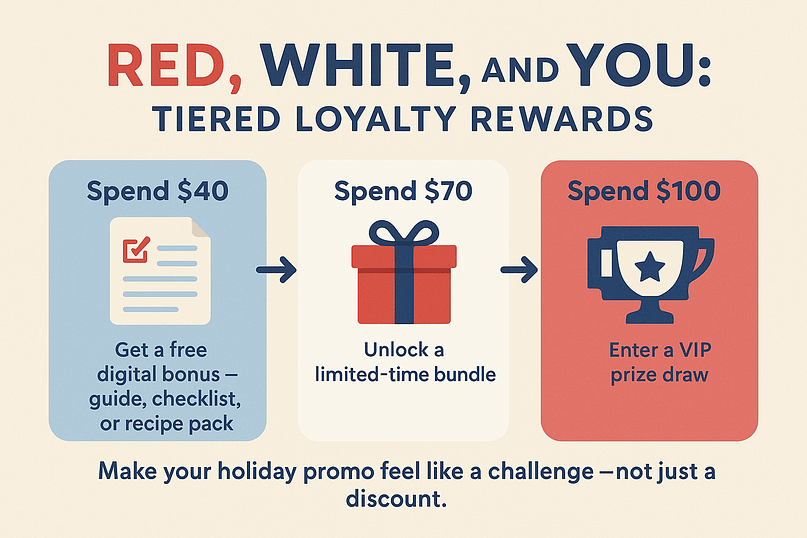
🛠 How I’d Set This Up (Without Spreadsheet Chaos)
If you’re using WooCommerce or Easy Digital Downloads (EDD), you can set up spending-based rewards using order total tracking + email triggers.
Here’s a simplified approach:
Use your ecommerce platform to track order values (WooCommerce has plugins for this, or you can set up basic logic with extensions like WooCommerce Points & Rewards or AutomateWoo)
Segment customers by how much they’ve spent during the campaign window
Trigger rewards manually (if you have low volume) or use your email tool to send rewards once they hit a certain threshold
👉 Want to gamify it even more? AffiliateWP can work if you’re tracking referrals and want to reward those who drive purchases, not just those who spend. But for a spend-based loyalty builder, start with the tools inside your ecommerce setup.
No spreadsheets, no complicated tracking — just a few smart automations and a clear reward structure.
💡 Why It Works
Encourages repeat purchases — without adding pressure
Makes the promo feel gamified and exciting
Shows your loyal customers a little extra love (and they remember that)
9. Run a Quiz That Ends in Content — Not Just a Product
I’ve always loved using quizzes for lead gen — but most of them hit you with a product pitch the second you click “See my results.”
That’s fine… but if you want people to stick around, share, and actually enjoy the experience, try this instead: Create a result page that feels like a curated lifestyle guide — one that delivers real value before it nudges the sale.
📝 Example:
Quiz: What’s Your Summer Long Weekend Vibe? Result: A personalized celebration plan with:
Quick outfit or product suggestions
Easy recipes or staycation ideas
A relevant product rec, tucked in like a natural next step
It’s the perfect middle ground for quiz-based lead generation: a little bit blog post, a little bit soft-sell, and fully designed to match your summer holiday marketing vibe.
🛠 How I’d Build It
Use Thrive Quiz Builder to handle the logic, tagging, and lead capture
Use Thrive Architect to build a custom result page that feels more like a magazine-style content piece than a sales page
It’s still a funnel — just one your audience actually wants to read.
💡 Why It Works
Feels low-pressure, fun, and helpful — which increases time on page and shares
Pairs perfectly with content-driven brands that sell lifestyle, wellness, or seasonal products
Helps grow your list and position your offer at the same time (without feeling like “just another sale”)
🚀 Ready to Launch? Start Small, Then Scale What Works
I know it’s tempting to try everything — the popup, the countdown, the quiz, the full-blown loyalty builder. But the truth is? You don’t need to do it all to make it work.
Start with one thing. Maybe it’s a scroll-triggered popup. Maybe it’s a short email sequence. Maybe it’s a quiz for your existing audience, just to test the waters.
Once you see what’s clicking, layer in the next thing — not because a checklist told you to, but because your audience responded.
🎯 Even one well-timed popup + a follow-up email can outperform a flashy 20% off banner with no real strategy behind it.
The magic isn’t in doing everything. It’s in doing what works — and doing it with intention.
And honestly? The more you enjoy the process, the more your audience will too.
FAQs: 4th of July Marketing Ideas That Actually Work
Got questions about what works, what to try, or when to start? You're not the only one. These are
1. What are some effective 4th of July marketing ideas for small businesses?
You don’t need a giant budget or a full production crew to run a great 4th of July campaign. Start with ideas that feel fun, intentional, and doable:
- Run a limited-time promo — Think “fireworks sale” with a countdown or bundle deal
- Highlight American-made or locally sourced products — It's simple, but it works
- Partner with nearby businesses — Team up on a giveaway or themed weekend event
- Host something small but memorable — Like a “red, white, and brew” in-store tasting or a themed social post contest
These kinds of summer holiday marketing ideas don’t just drive sales — they help your brand show up as part of the celebration.
2. How can I make my 4th of July campaign stand out?
Most brands just shout “20% off everything!” and hope for the best.
To cut through the noise, try:
- Personalized messaging — Segment your list, tailor your copy
- Interactive content — A short quiz, poll, or even a holiday checklist goes a long way
- User-generated content — Encourage people to share how they’re celebrating with your product
- Creative deals — Instead of a discount, try a free gift with purchase, a limited-time bundle, or a “mystery item” drop
In short: make it a little more human, a little more unexpected — and you’re already ahead of half the inbox.
3. When should I start planning my 4th of July marketing?
If you’re asking this on June 30… it’s not too late, but it’s tight.
Ideally, give yourself 4–6 weeks so you can:
- Plan your offers and promo calendar
- Design campaign visuals
- Schedule emails, social posts, and maybe even a quiz or landing page
- Build anticipation with a teaser or early access opt-in
More time = less panic = a campaign that actually converts and feels good to run.
4. What types of promotions work best for the 4th of July?
Not every brand needs to discount aggressively — but if you’re running a promo, make it something people want to act on:
- Flash sales — Short and punchy, especially with a countdown timer
- Themed product bundles — Think BBQ kits, summer starter packs, or “long weekend essentials”
- Exclusive offers — Like free shipping, a gift with purchase, or early access for email subscribers
- Contests and giveaways — Great for social engagement and list growth when paired with something shareable
The best promotions don’t just lower the price — they raise the perceived value.
Conclusion: Campaigns Like This Build Brands People Actually Want to Buy From
Most 4th of July promos are forgotten by July 6th.
They blend into the noise — same old discounts, same generic banners.
But the good ones? The ones people actually remember and share? They’re built with intention. They feel personal. And they guide the customer toward something that makes sense.
So if you're running a campaign this year, make it count.
Start with one clear offer. Use tools that make your life easier — not more complicated. And pay attention to what’s actually working. If something doesn’t help your customer take the next step? Either fix it or cut it.
💡 Not sure where to start? A simple popup + quiz combo is one of my favorite fast wins. It’s engaging, easy to test, and way more fun than chasing one-click discounts that don’t convert.
And if you want to build all of it — from landing pages and quizzes to timers and lead capture — Thrive Suite has everything you need to pull it off like a pro (even if you’re flying solo).


